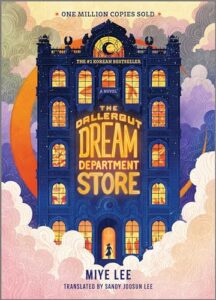 The Dallergut Dream Department Store Series: The Dallergut Dream Department Store #1
The Dallergut Dream Department Store Series: The Dallergut Dream Department Store #1 Genres: Adult, Asian Literature, Korean Literature, Fantasy, Low Fantasy, Fiction, Magical Realism, Cozy Fantasy
Published by Hanover Square Press on July 9, 2024
Pages: 207

For fans of magical realism and the Before the Coffee Gets Cold series by Toshikazu Kawaguchi comes this cozy fantasy debut.
What if there was a store that sold dreams? Which would you buy? And who might you become when you wake up?
In a mysterious town hidden in our collective subconscious there's a department store that sells dreams. Day and night, visitors both human and animal shuffle in to purchase their latest adventure. Each floor specializes in a specific type of childhood memories, food dreams, ice skating, dreams of stardom. Flying dreams are almost always sold out. Some seek dreams of loved ones who have died.
For Penny, an enthusiastic new hire, working at Dallergut is the opportunity of a lifetime. As she uncovers the workings of this whimsical world, she bonds with a cast of unforgettable characters, including Dallergut, the flamboyant and wise owner, Babynap Rockabye, a famous dream designer, Maxim, a nightmare producer, and the many customers who dream to heal, dream to grow, and dream to flourish.
A captivating story that will leave a lingering magical feeling in readers' minds, this is the first book in a bestselling duology for anyone exhausted from the reality of their daily life.
Creatively whimsical, The Dallergut Dream Department Store fits nicely into the cozy magical realism/fantasy-feel genre that admittedly is normally not my thing. Lee’s debut novel follows a similar formula of other Asian-translated cozy reflective stories in a similar style of Kawaguchi’s Before the Coffee Gets Cold or Aoyama’s What You Are Looking for is in the Library. However unlike many books it’s drawn similarities to, The Dallergut Dream Department Store is presented in a far more whimsical manner that focuses on the Dream Village and the inner workings of how dreams are created, sold, and used by sleeping customers. Like those other novels, there isn’t much of an overall plot or storyline as the main character Penny serves as a surrogate for the reader experiencing and learning about the Dallergut Dream Store. While I wasn’t necessarily hooked by this book, I was impressed by its creativity and appreciative of how well it accomplished what it was trying to do with its premise. At just over 200 pages, it’s also an incredibly easy and breezy read that you can pick up and put down casually without sacrificing details or the reading experience.
Cozy reads are typically not my go-to genre, and lately I’ve had a difficult time reading similar books previously mentioned due to perhaps cultural differences as well as dramatic emotional moments feeling entirely unwarranted (I acknowledge that some literary details and style may also be lost in translation). While being impressed by their concept, particularly Before the Coffee Gets Cold being a coffee lover myself, I had a lot of issues with these novels coming off as preachy and severely overestimating how insightful their reflections were which resulted in their emotional impact falling comically flat. The Dallergut Dream Department Store sidesteps those problems completely by focusing on the world of the Dream Village rather than individual customers’ lives and how they react to the dreams. The book does have several vignettes that focus on select customers’ dreams purchased from the store, however these stories are not meant to be emotional or give development for the character, but instead meant to present a visual example for whatever concept the novel is introducing. For example, the first vignette focuses on a young woman in her 20’s feeling unfulfilled being single. Her dream focuses on a workplace 3rd party vendor/collaborator and potential crush that she’s hesitant to make the first move towards. This short story is not meant to focus on Ah-young’s romantic life but instead meant to show how a dream is purchased from the store, experienced, and then paid for by taking a small commission percentage of the emotions/feelings the customer experiences after awakening. Her feelings towards the dream inspire her to reach out to her crush irl but the main purpose was to show how she experiences the feeling of “flutter” and how the store receives her payment.
Other vignettes follow a similar formula of a dream concept followed by a story such as a screenwriter struggling to come up with a new premise while the dream she purchases is a working demonstration of precognitive dreams (essentially the explanation behind the feeling of deja vu). Another story focuses on customers reliving one of their most stressful times of their lives meant to showcase how trauma dreams are used and how their purpose can benefit the dreamer in the long-run. One story even flips the readers’ expectation on itself with the customer ultimately succeeding in their endeavor by not purchasing a dream at all. These world-building elements and example stories are good as-is, but Lee enhances them by often connecting these dream customers to each other (ie. the screenwriter is best friends with the single office woman). While none of these stories are particularly moving or deep, they accomplish exactly what they’re meant to do and most importantly, don’t attempt to be anything they’re not, such as overly dramatic. Even the dreams that handle the topics of past trauma and loss are still written in a light manner that doesn’t drag down the comfortable tone Lee maintains.
The creativity and way Lee incorporates different aspects of dreams, imagination, and sleep is all wonderful. Besides the aforementioned experience of deja vu, the novel also covers how dreams are made, how they are sold and used, even a Best Of awards show highlighting the popularity or critical elements of dreams. I also found how the novel addressed recent trends of people not getting enough sleep from overwork or browsing social media to be amusing and how the lack of sleep is heavily affecting the revenue and demand for dreams. Lee also covers precognition, traumatic moments, holiday dreams (yes Santa Claus makes an unexpected appearance), dreams experienced by pets and animals, and my personal favorite which is dreams where one encounters those who have already passed away. Pardon the bad pun, but some of these ideas feel like something you could only come up with in a fever dream. Yet it all works well, Lee’s Dream village and the Dallergut Department store feel fully lived-in and developed. And despite what’s covered, the concept is solid enough that I can easily see this being a series that continues to build on itself (a sequel already exists though it hasn’t been announced if Hanover Square Press will also be translating and publishing it).
Perhaps the biggest drawback of the Dallergut Dream Department Store is that there isn’t a real storyline or the traditional book elements of conflict and resolution; there are only two mild conflicts but I wouldn’t even call them conflicts for how minor they are. All two hundred pages are spent quietly exploring the world of dreams and Penny’s increasing knowledge while working at the store. I also found the book to be translated wonderfully by Sandy Joosun Lee, not suffering from any recurring issues I’ve noticed in many Asian translated works. My only mild nitpicks is that I would’ve liked if the book had a bit of a bigger hook (while comfy, it was a bit too low-stakes and casual for me) and I wish that the two epilogue chapters at the end of the book were swapped. The first epilogue addresses the minor mystery of why one of the store floor managers was expelled from the Dream Academy/University for dream-making while the second resolves the conflict of a stolen bottle of feelings currency. The first epilogue chapter was far more interesting and had more impact to me, which would’ve made a more memorable and lasting impact had the book closed with that chapter. On the other hand, I understand that putting the other epilogue chapter last tied the conclusion back to Penny since the bottle was stolen under her possession. Minor comments aside though, this was a lovely read that pleasantly surprised me in a genre I typically do not care for (overall 3.5 rounded up, but if I was scoring this based on creativity and concept, easy 4.5).
